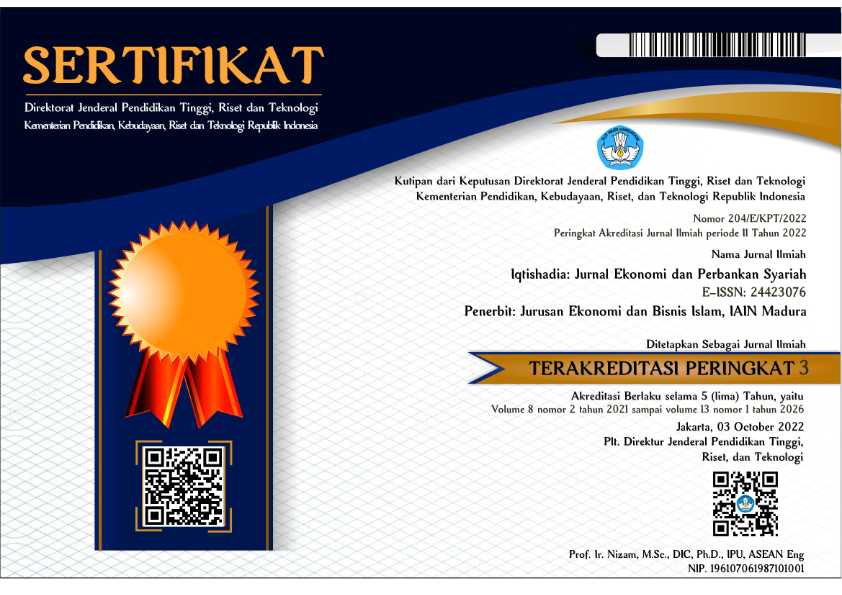Analis Perbandingan Bank Umum Syariah Dengan Unit Usaha Syariah Dari Aspek Efisiensi; Kualitas Asset Dan Stabilitas Keuangan (Periode Tahun 2014-2017)
 Abstract views: 1653
,
Abstract views: 1653
,
 PDF downloads: 1262
PDF downloads: 1262
Abstract
This research aims to compare efficiency, quality of assets and financial stability between Sharia banks (BUSES) and Sharia business units (UUS). Efficiency variables are formulated with the ratio of operating costs compared to the operating income (BOPO), the quality of the asset is made in the ratio of non-performing financing (NPF), namely the comparison of problematic financing with total Financing, and financial stability that is redefined with Return On Asset (ROA) is a comparison of the profit generated by the bank with the total assets owned by the bank. The method in this research is the quantitative method of using descriptive test and T test. Based on the descriptive results and test T, the efficiency, quality of assets and financial stability of the UUS is better when compared to the BUS.
[Penelitian ini bertujuan untuk membandingkan efisiensi, kualitas asset dan stabilitas keuangan antara bank umum syariah (BUS) dan unit usaha syariah (UUS). Variabel efisiensi diformulasikan dengan rasio biaya operasional dibandingkan dengan pendapatan operasional (BOPO), kualitas asset diproxykan dengan rasio non-performing financing (npf) yaitu perbandingan antara pembiayaan bermasalah dengan total pembiayaan yang disalurkan, dan stabilitas keuangan yang diproxykan dengan Return On Asset (ROA) yaitu perbandingan laba yang dihasilkan oleh bank dengan total asset yang dimiliki oleh bank. Metode dalam penelitian ini adalah metode kuantitatif yaitu memggunakan uji deskriptif dan uji T. Berdasarkan hasil deskriptif dan uji T, maka efisiensi, kualitas asset dan stabilitas keuangan dari UUS lebih baik apabila dibandingkan dengan BUS.]Downloads
References
Abidin, Z., & Endri. (2009). Kinerja Efisiensi Teknis Bank Pembangunan Daerah : Pendekatan Data Envelopment Analysis ( DEA ). Jurnal Akuntansi Dan Keuangan, 11, 21–29. Retrieved from http://jurnalakuntansi.petra.ac.id/index.php/aku/article/view/17863
Agustiningrum, R. (2013). Analisis Pengaruh CAR, NPL, dan LDR terhadap Profitabilitas pada Perusahaan Perbankan. Jurnal Manajemen Universitas Udayana, 2(8), 885–902.
Ahmad, S., & Abdul Rahman, A. R. (2012). The efficiency of Islamic and conventional commercial banks in Malaysia. International Journal of Islamic and Middle Eastern Finance and Management, 5(3), 241–263. https://doi.org/10.1108/17538391211255223
Aini, N. (2013). Pengaruh CAR, NIM, LDR, NPL, BOPO, dan Kualitas Aktiva Produktif terhadap Perubahan Laba (Studi Empiris pada Perusahaan Perbankan yang Terdaftar di BEI) Tahun 2009-2011. Dinamika Akuntansi, Keuangan Dan Perbankan, 2(1), 14–25.
Amrullah, M. A. (2002). Politik Hukum Pidana dalam Korban Kejahatan Ekonomi di Bidang Perbankan. Jurnal Hukum, 9(21), 23–43.
Anisah, L. (2013). Pengaruh Tingkat Kesehatan Bank terhadap Pertumbuhan Laba pada BPR di Indonesia. Jurnal Ekonomi Dan Keuangan, 1(4), 27–37.
Anjani, D. A., & Purnawati, N. K. (2014). Pengaruh Non Performing Loan (Npl), Likuiditas dan Rentabilitas terhadap Rasio Kecukupan Modal. Bisnis Dan Manajemen (Jbima), 2(1), 1–19.
Arafah, W., & Nugroho, L. (2016). Maqhashid Sharia in Clean Water Financing Business Model at Islamic Bank. International Journal of Business and Management Invention (IJBMI), 5(2), 22–32. Retrieved from http://www.ijbmi.org/papers/Vol(5)2/Version -3/D05203022032.pdf
Arianti, D., Andini, R., & Arifati, R. (2016). Pengaruh BOPO,NIM, NPL, dan CAR terhadap jumlah penyaluran kredit pada perusahaan perbankan yang go publik di bursa efek Indonesia periode tahun 2010-2014. Journal of Accounting, 2(2).
Arief, S. (2012). Konsumen Rasional dalam Perspektif Islam. Islamic Economics Journal, 1(1), 17–30.
Asiedu, E. (2005). The Role of Natural Resources, Market Size, Government Policy, Institutions and Political Instability. World Institute for Development Economics Research Working Paper, 2005(24).
Bachruddin. (2006). Pengukuran Tingkat Efisiensi Bank Syariah dan Bank Konvensional di Indonesia dengan Formula David Cole’s Roe for Bank. Jurnal Siasat Bisnis (JSB), 11(1), 67–80.
Baharun, H. (2016). Manajemen Kinerja Dalam Meningkatkan Competitive Advantage Pada Lembaga Pendidikan Islam. At-Tajdid: Jurnal Ilmu Tarbiyah, 5(2), 243–262.
Beck, T., Kunt, A. D., & Merrouche, O. (2010). Islamic Vs . Conventional Banking : Business Model , Efficiency and Stability Islamic vs . Conventional Banking Business Model , Efficiency and Stability. Journal of Banking & Finance, 37(October), 433–447. https://doi.org/10.1016/j.jbankfin.2012.09.016
Bester, H. (1987). The role of collateral in credit markets with imperfect information. European Economic Review, 31, 887–899.
Cowton, C. J. (2002). Integrity , responsibility and affinity : three aspects of ethics in banking 1. Business Ethics: A European Review, 11(4), 393–400.
Dienillah, A. A., & Anggraeni, L. (2016). Dampak inklusi keuangan terhadap stabilitas sistem keuangan di asia. Buletin Ekonomi Moneter Dan Perbankan, 18(4), 409–430.
Entrisnasari, F. V. (2015). Analisis Portofolio Optimum Saham Syariah Menggunakan Mean Semivarian. JURNAL FOURIER, 4(1), 41–57.
Friedman, M. (1968). The Role of Monetary Policy. Essential Readings in Economics, LVIII(1), 215–231.
Haneef, S., Rana, M. A., & Karim, Y. (2012). Impact of Risk Management on Non-Performing Loans and Profitability of Banking Sector of Pakistan Hailey College of Commerce University of the Punjab Hafiz Muhammad Ishaq Federal Urdu University of Arts , Science and Technology. International Journal of Business and Social Science, 3(7), 307–315.
Haryati, S. (2009). Pertumbuhan kredit perbankan di indonesia: intermediasi dan Pengaruh variabel makro ekonomi. Jurnal Keuangan Dan Perbankan, 13(2), 299–310.
Hayo, B. (1998). Inflation Culture, Central Bank Independence and Price Stability. European Journal of Political Economy, 14(January), 241–263.
Huri, M. D., & Susilowati, I. (2004). Pengukuran Efisiensi Relatif Emiten Perbankan Dengan Metode Data Envelopment Analysis (DEA) (Studi Kasus: Bank-bank yang Terdaftar di Bursa Efek Jakarta Tahun 2002). Jurnal Dinamika Pembangunan (JDP), 1(2), 95–110.
Jensen, M., & Meckling, W. (1976). Theory of the firm: Managerial behaviour, agency costs and ownership. Strategic Management Journal, 21(4), 1215–1224. Retrieved from http://search.ebscohost.com/login.aspx?direct=true&db=buh&AN=12243301&site=ehost-live
Juwana, H. (2017). Analisa Ekonomi atas Hukum Perbankan. Jurnal Hukum & Pembangunan, 28(1–3), 83. https://doi.org/10.21143/jhp.vol28.no1-3.537
Karmeli, E., & Fatimah, S. (2008). Krisis Ekonomi Indonesia. Journal of Indonesian Applied Economics, 2(2), 164–173. https://doi.org/10.1002/cae.20304
Kim, J., & Mahoney, J. T. (2002). Property Rights Theory , Transaction Costs Theory , and Agency Theory : An Organizational Economics Approach to Strategic Management. Managerial and Decision Economics, 26(January), 223–242. https://doi.org/10.1002/mde.1218
Kristianti, D. S. (2014). Kartu kredit syariah dan perilaku konsumtif masyarakat. Ahkam, 14(2), 287–296.
Muazaroh, Eduardus, T., Husnan, S., & Hanafi, M. M. (2012). Determinants of Bank Profit Efficiency: Evidence from Indonesia. International Journal of Economics and Finance Studies, 4(2), 164–173.
Nugroho, L., & Anisa, N. (2018). Pengaruh Manajemen Bank Induk, Kualitas Aset, dan Efisiensi terhadap Stabilitas Bank Syariah di Indonesia (Periode Tahun 2013-2017). Inovbiz: Jurnal Inovasi Bisnis, 6(2), 114–122.
Nugroho, L., & Bararah, H. N. (2018). Pengaruh Good Corporate Governance dan Biaya Operasional dan Pendapatan Operasional (BOPO) terhadap stabilitas keuangan bank umum syariah di Indonesia Tahun 2012-2017. Inovbiz: Jurnal Inovasi Bisnis, 6(2), 160–169.
Nugroho, L., Hidayah, N., & Badawi, A. (2018). The Islamic Banking, Asset Quality: “Does Financing Segmentation Matters” (Indonesia Evidence). Mediterranean Journal of Social Sciences, 9(5), 221–235. https://doi.org/10.2478/mjss-2018-0154
Nugroho, L., & Husnadi, T. C. (2017). Maslahah and Strategy to Establish A Single State-Owned Islamic Bank in Indonesia. Tazkia Islamic Finance and Business Review, 10(1), 17–33. Retrieved from http://www.tifbr-tazkia.org/index.php/TIFBR/article/view/97/106
Nugroho, L., Utami, W., Doktoralina, C. M., Soekapdjo, S., & Husnadi, T. C. (2017). Islamic Banking Capital Challenges to Increase Business Expansion (Indonesia Cases). International Journal of Commerce and Finance, 3(2), 1–10.
Nugroho, L., Utami, W., Sukmadilaga, C., & Fitrijanti, T. (2017). The Urgency of Allignment Islamic Bank to Increasing the Outreach. International Journal of Economics and Financial Issues, 7(4), 283–291. Retrieved from https://www.econjournals.com/index.php/ijefi/article/view/4493/pdf
Nugroho, L., Villaroel, W., & Utami, W. (2017). The Challenges of Bad Debt Monitoring Practices in Islamic Micro Banking. European Journal of Islamic Finance, 11, 1–11.
Prasanjaya, A. A. Y., & Ramantha, I. W. (2013). Analisis pengaruh rasio car, bopo, ldr dan ukuran perusahaan terhadap profitabilitas bank yang terdaftar di bei. E-Jurnal Akuntansi Universitas Udayana, 4(1), 230–245.
Premachandra, I. M., & Shi, J. (1998). Measuring the relative efficiency of fund management strategies in New Zealand using a spreadsheet-based stochastic data envelopment analysis model. Omega, 26(2), 319–331. https://doi.org/10.1016/S0305-0483(98)00002-4
Raharjo, E. (2007). Teori Agensi dan Teori Stewarship dalam Perspektif Akuntansi. Fokus Ekonomi, 2(1), 37–46.
Sarwono, H. A., & Warjiyo, P. (2003). Mencari Paradigma Baru Manajemen Moneter Dalam SIstem Nilai Tukar Fleksibel: Suaru Pemikiran untuk Penerapannya di Indonesia. Buletin Ekonomi Moneter Dan Perbankan, 1(1), 5–23. https://doi.org/10.21098/bemp.v1i1.158
Satibi, E., Nugroho, L., & Utami, W. (2018). A Comparison of Sharia Banks and Conventional Banks in Terms of Efficiency, Asset Quality and Stability in Indonesia for the Period 2008-2016. International Journal of Commerce and Finance, 4(1), 134–149.
Satibi, E., & Utami, W. (2015). Studi Komparasi Efisiensi, Kualitas Aset dan Stabilitas Pada Bank Umum Syariah dan Bank Umum Konvensional di Indonesia Periode 2010-2014. Jurnal Ilmu Ekonomi Dan Sosial, 4(1), 104–114.
Sudarsono, H. (2009). Dampak Krisis Keuangan Global terhadap Perbankan di Indonesia: Perbandingan antara Bank Konvensional dan Bank Syariah. La_Riba, 3(1), 12–23. https://doi.org/10.20885/lariba.vol3.iss1.art2
Suganda, A. D. (2015). Mengurangi Tingkat Risiko dengan Manajemen Islami. Jurnal Ekonomi Islam, 6(2), 1–14.
Sukmadilaga, C., & Nugroho, L. (2017). Pengantar Akuntansi Perbankan Syariah “Prinsip, Praktik dan Kinerja” (First). Bandar Lampung, Indonesia: Pusaka Media.
Utami, W., & Nugroho, L. (2018). Potential Big Bath Accounting Practice in CEO Changes (Study on Manufacturing Companies Listed in Indonesia Stock Exchange). International Journal of Accounting and Finance Studies, 1(2), 202–215. https://doi.org/10.22158/ijafs.v1n2p202
Vania, A. S., Nugraha, E., & Nugroho, L. (2018). Does Earning Management Happen in Islamic Bank ? (Indonesia and Malaysia Comparison). International Journal of Commerce and Finance, 4(2), 47–59.
Wahab, A., Hosen, M. N., & Muhari, S. (2015). Komparasi Efisiensi Teknis Bank Umum Konvensional (BUK) dan Bank Umum Syariah (Bus) di Indonesia dengan Metode Data Envelopment Analysis (DEA). Al-Iqtishad: Journal of Islamic Economics, 6(2), 179–194. https://doi.org/10.15408/ijies.v6i2.1229
Wibisono, Y. (2009). Politik Ekonomi UU Perbankan Syariah Peluang dan Tantangan Regulasi Industri Perbankan Syariah. Jurnal Ilmu Administrasi Dan Organisasi, 16, 105–115.
The journal operates an Open Access policy under a Creative Commons Non-Commercial Share-Alike license. All articles published Open Access will be immediately and permanently free for everyone to read and download.
• Creative Commons Attribution-NonCommercial (CC-BY-NC)

Iqtishadia: Jurnal Ekonomi dan Perbankan Syariah by http://ejournal.iainmadura.ac.id/index.php/iqtishadia is licensed under a Creative Commons Attribution-NonCommercial 4.0 International License.
Based on a work at http://ejournal.iainmadura.ac.id.


























